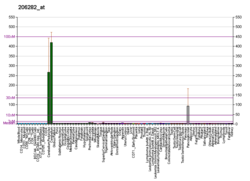Neurogenic differentiation 1 (Neurod1), also called β2,[5] is a transcription factor of the NeuroD-type. It is encoded by the human gene NEUROD1.
In mice, Neurod1 expression is first seen at embryonic day 12 (E12).[6]
It is a member of the Neurod family of basic helix-loop-helix (bHLH) transcription factors, composed of Neurod1, Neurod2, Neurod4, and Neurod6. The protein forms heterodimers with other bHLH proteins and activates transcription of genes that contain a specific DNA sequence known as the E-box. It regulates expression of the insulin gene, and mutations in this gene result in type II diabetes mellitus in mouse models and in human clinical patients.[7]
Neurod1 is found to convert reactive glial cells into functional neurons in the mouse brain in vivo[8] In the adult cortex, Neurod1 expression is a marker of mature excitatory pyramidal neurons in the upper-most layers of the cortex.[9]
- ^ a b c GRCh38: Ensembl release 89: ENSG00000162992 – Ensembl, May 2017
- ^ a b c GRCm38: Ensembl release 89: ENSMUSG00000034701 – Ensembl, May 2017
- ^ "Human PubMed Reference:". National Center for Biotechnology Information, U.S. National Library of Medicine.
- ^ "Mouse PubMed Reference:". National Center for Biotechnology Information, U.S. National Library of Medicine.
- ^ Poulin G, Turgeon B, Drouin J (November 1997). "NeuroD1/beta2 contributes to cell-specific transcription of the proopiomelanocortin gene". Molecular and Cellular Biology. 17 (11): 6673–6682. doi:10.1128/mcb.17.11.6673. PMC 232521. PMID 9343431.
- ^ Bormuth I, Yan K, Yonemasu T, Gummert M, Zhang M, Wichert S, et al. (January 2013). "Neuronal basic helix-loop-helix proteins Neurod2/6 regulate cortical commissure formation before midline interactions". The Journal of Neuroscience. 33 (2): 641–651. doi:10.1523/JNEUROSCI.0899-12.2013. PMC 6704922. PMID 23303943. S2CID 25600245.
- ^ Malecki MT, Jhala US, Antonellis A, Fields L, Doria A, Orban T, et al. (November 1999). "Mutations in NEUROD1 are associated with the development of type 2 diabetes mellitus". Nature Genetics. 23 (3): 323–328. doi:10.1038/15500. PMID 10545951. S2CID 3216136.
- ^ Guo Z, Zhang L, Wu Z, Chen Y, Wang F, Chen G (February 2014). "In vivo direct reprogramming of reactive glial cells into functional neurons after brain injury and in an Alzheimer's disease model". Cell Stem Cell. 14 (2): 188–202. doi:10.1016/j.stem.2013.12.001. PMC 3967760. PMID 24360883.
- ^ Tutukova S, Tarabykin V, Hernandez-Miranda LR (2021). "The Role of Neurod Genes in Brain Development, Function, and Disease". Frontiers in Molecular Neuroscience. 14: 662774. doi:10.3389/fnmol.2021.662774. PMC 8221396. PMID 34177462.




